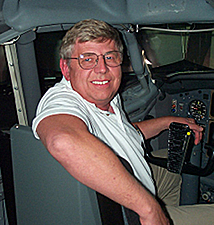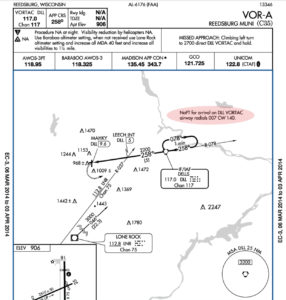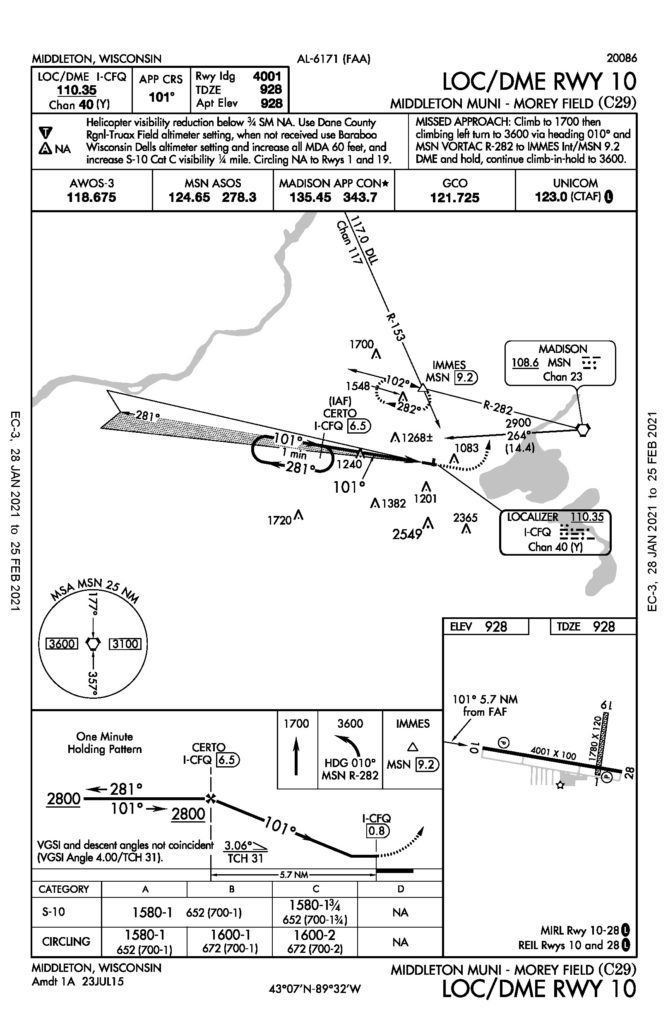The Procedure Turn and When Is It Required?
By Michael “Mick” Kaufman

I try to stay informed in the happenings in the aviation world, and I read the columns of many aviation journalists in numerous publications. I try to be different from the rest by using my own real-life observances rather than putting my own twist on someone else’s ideas or writings. I stay active as a pilot and instructor and like to relate real experiences to help my readers with some of the problem areas I have encountered. I previously did several IPC checks and an old topic resurfaced, “Do I really need to do a procedure turn?”. The procedure turn will be the primary topic of this issue of BPT TAKEOFF.
Many pilots — including professional pilots — do not have a good understanding of procedure turns and have erred at one time or another when cleared for an approach. In helping them understand procedure turns, I often make reference to the book that I labeled as the instrument flight training bible, Instrument Flight Training Manual by Peter Dogan, first published more than a decade ago. It states that you must do a procedure turn unless one of the following criteria exists:
- You are getting radar vectors
- You are in a holding pattern*
- You are on a no-procedure turn transition
- You are flying a DME arc
- No procedure turn is shown on the chart
I will elaborate on each of the criteria for your better understanding.
When a pilot is given radar vectors, he or she is never to do a procedure turn or course reversal. This is the most common criterion from the 5 that I mentioned above, but it can be confusing. I taught a seminar at Volk AFB in Wisconsin a number of years back as part of an open house, and one of the pilot attendees decided to do a procedure turn on his way home in IMC conditions when supposedly being given radar vectors. This prompted me to modify my future lectures on procedure turns. If you are unsure whether you are being given radar vectors, ASK! The air traffic controllers’ handbook states that the controller is to advise the reason for the vector when giving the pilot the first radar vector.
Example: N2852F turn right heading 260 this will be a vector for your climb.
N22HB fly heading 330 for vectors around military airspace.
N9638Y turn left heading 210 this will be a vector for the ILS 36 approach at Madison.
My experience has shown that this is not always done by controllers and leaves a question of doubt in the pilots’ minds. On an IMC approach into Oshkosh some time ago as part of a BPT flight clinic, Chicago Center was giving us traffic vectors and then cleared us for the approach. We were nowhere in a position to begin the approach, so we needed to fly to the initial approach fix (IAF) and do the procedure turn. The procedure turn is a time-consuming and fuel-wasting procedure, and sometimes the only way to “legally” eliminate it is with radar vectors. I find that a procedure turn will average about 8 additional minutes of flying time compared to a straight-in approach. If this is the case, it does not hurt to ask ATC for radar vectors.
Example: (Pilot) “Is there any chance of radar vectors for the VOR A approach to the 93C airport?” (Controller) “N9638Y turn right, heading 300 and join the initial approach course for the straight-in VOR A approach to the 93C airport”.
I refer to this as the “controller blessing the straight-in approach”, and it saved you some time and fuel, but it must be done safely and legally according to the regulations. The second method of omitting a procedure turn is a holding pattern, but not just any holding pattern as the reason for the asterisk in my list above. The description of this holding pattern is found in the Aeronautical Information Manual and was rewritten from the original easy-to-understand edition several versions back. What is referred to here is, when holding at the final approach fix or at an intermediate approach fix that is aligned with the final approach course, a procedure turn is never done when cleared for the approach. So, the key here is “aligned with the final approach course.”

Let’s look at figure 1, and we can see the missed approach hold over the DLL VOR with the inbound leg of the hold going in the same direction as the final approach course that the pilot is to fly. This is a classic example of what the regulation is talking about.
When in this hold and an approach clearance is received, the pilot is expected to leave the hold and proceed inbound the very next time he or she crosses the holding fix.
There is nothing wrong with asking for a deviation from this rule if it cannot be complied with, but the pilot must receive permission from ATC in order to do so.
An example would be that the pilot was instructed to hold at the DLL fix shown in fig 1 at 6000 feet, and it would be impossible for the pilot to cross the final approach fix at the published crossing altitude of 3000 feet inbound on the approach. The pilot has three options if this should occur:
- Ask ATC for one more loop around the holding pattern to lose altitude.
- Ask ATC for a longer outbound leg to allow for the descent in the hold.
- Request a procedure turn from ATC for the purpose of losing altitude which would not apply in this case as the holding pattern is the procedure turn.
When flying a NOPT transition, there seems to be a lot of confusion on doing a procedure turn (course reversal) when the heading being flown to the fix lines up somewhat close to the inbound approach course. The TERPS-ters (the people who write the TERPS) when laying out the approach will designate that no procedure turn should be made as they have in FIG 1 of the VOR A approach to Reedsburg, WI (C35). This is really a No Procedure Turn Transition (NOPT) shown, and I refer to it as a “blanket transition” (MJK) as it covers a rather broad area. If we were approaching the DLL VOR from the northeast between the 007-degree radial clockwise to the 140-degree radial and we see the notation on the approach chart, we would know that we would not be doing a procedure turn or course reversal.

In FIG 2, a similar approach, the LOC/DME 10 approach into the Middleton Morey Airport (C29), we do not see a blanket transition, or a transition of any type shown on this chart. With guidance from the AIM (section 5-4-7i) and the ATC Handbook (section 4-8-1) to properly do the approach as designed by the TERPS-ters, it would then be mandatory to do the racetrack procedure turn as shown.
The ATC handbook says the following: “If a hold in lieu of a procedure turn is depicted and a straight-in area is not defined (e.g., “No PT” indicated at the fix), the aircraft must be instructed to conduct a straight-in approach if ATC does not want the pilot to execute a procedure turn. So, what would it hurt, or would there be any danger to the pilot if he did not do the procedure turn on the Morey Middleton LOC 29 approach? Probably not, but many times it could be disastrous.
Let’s take a similar approach in mountainous terrain, and the approach becomes disastrous and fatal as in the case of Cirrus N893MK into Santa Clara, CA (KRHV). There were errors made in part by both the pilot and ATC that were all contributors to this accident. Keep in mind that there are three ways to get established: an approach from over an IAF/feeder route, direct to an intermediate fix (IF) in certain cases, or vectors to final.
There is one more item for the pilot to consider when making a request. There is a big difference between: “direct to” and “radar vectors.” When the pilot makes a “direct to” request from ATC on an IFR flight plan, the pilot is responsible for terrain clearance and ATC is responsible for traffic. On a radar vector’s clearance, ATC is responsible for both traffic and terrain separation.
This accident is pointed out in one of my favorite instrument flying books: Instrument Flying Update by John Eckalbar. If you don’t have this book, consider it a must for your library. It will help clarify a lot of confusion for you on approaches.
The fourth criterion to eliminate a procedure turn is when flying a DME arc. It is fairly straightforward as far as a procedure turn is concerned; you just don’t do one. I have several notes on the arc, and that is how the clearance is given to you. The standard procedure is to always join the arc at the initial approach fix unless directed by ATC. For example, if ATC should give you this clearance:
“Bonanza 9JB fly heading 340 to join 10 DME arc south of LNR.”
First, we must know from a request or clearance what approach we are doing to make any sense of this clearance and have the approach chart. This clearance gives the pilot permission to avoid going to the IAF and save some time; however, it does not give him permission to descend prior to or once established on the arc.
If the words “cleared for the approach” had been included in the transmission, the pilot could descend to the altitude specified on the chart once on a published segment of the approach.
“Bonanza 9JB fly heading 340 to join the 10 DME arc south of LNR, maintain 4,200 until established on a segment of the approach, you are cleared for the VOR 25 approach to the Boscobel airport, report established on the arc.”
Now, we have permission to avoid the IAF, and once on the arc we can descend as the arc is a published segment of the approach. After reporting established on the ARC, no more communications are necessary with ATC except canceling IFR or going missed. ATC will probably have you switch to the CTAF when you report established on the ARC and remind you to cancel IFR unless you go missed.
The fifth and final exclusion to a procedure turn is the simplest to describe: there is no procedure turn shown on the chart. In which case, radar is always required, or the approach can’t be done. This is the case at class B airports and many of the other larger airports.
There is a lot to be said about the procedure turn, which we can save for a future eNewsletter. None of us would choose to do a procedure turn if we did not have to – and now you know the rules of when they are required.
I am always happy and willing to answer any of our readers’ questions and comments on topics and the contents of my articles, so let me hear from you. I am excited about seeing our flight training clinics resume after a hiatus caused by the pandemic.
Hope to see you soon, and fly safe!
Mick
Cell 817-988-0174



